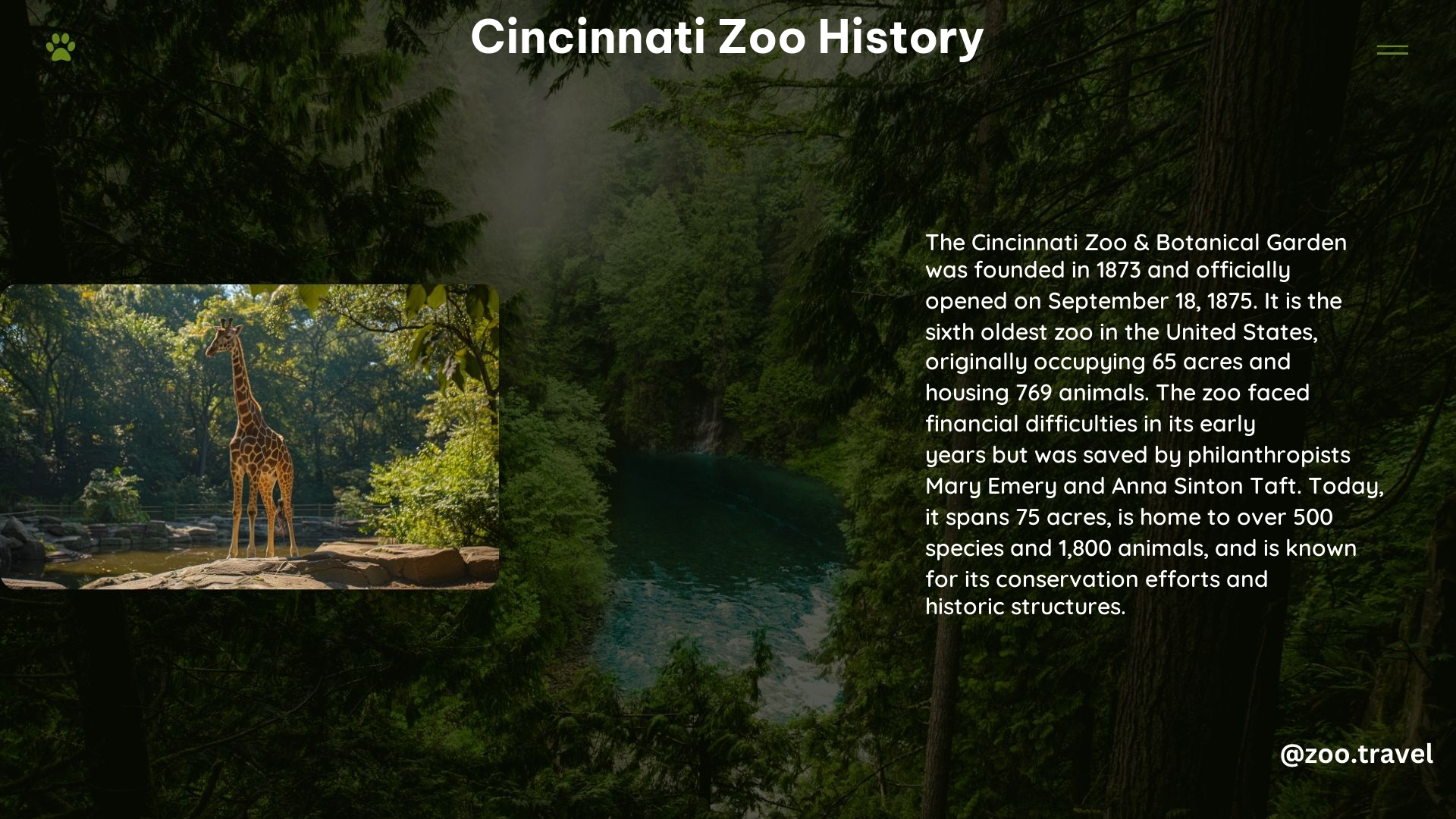The Cincinnati Zoo, founded in 1875, is the sixth oldest zoo in the United States, boasting a rich and fascinating history that spans over a century and a half. From its humble beginnings with just a few animals to its current status as a leading zoological institution, the Cincinnati Zoo has evolved and adapted to the changing times, offering visitors a unique and unforgettable experience.
Founding and Early Years
The Cincinnati Zoo was founded on September 18, 1875, by Andrew Erkenbrecher, the president of Cincinnati’s first telephone company. The initial zoo covered 66.4 acres and housed a diverse collection of 769 animals, including eight monkeys, two grizzly bears, three white-tailed deer, six raccoons, two elk, a buffalo, a laughing hyena, a tiger, an American alligator, a circus elephant, and over 400 birds, including a talking crow.
| Year | Key Fact |
|---|---|
| 1875 | The Cincinnati Zoo was founded by Andrew Erkenbrecher, the president of Cincinnati’s first telephone company. |
| 1875 | The initial zoo covered 66.4 acres and housed 769 animals. |
Early Challenges and Changes

The Cincinnati Zoo faced financial difficulties in its first 20 years, leading to the sale of 22 acres in 1886 and eventual receivership in 1898. However, the zoo’s fortunes changed in 1901 when the Cincinnati Traction Company purchased the zoo, and in 1917, the Cincinnati Zoological Park Association took over management. The city of Cincinnati then purchased the zoo in 1932, marking a transition to stable growth and fiscal stability.
- The zoo faced financial issues in its first 20 years, leading to the sale of 22 acres in 1886 and eventual receivership in 1898.
- In 1901, the Cincinnati Traction Company purchased the zoo, and in 1917, the Cincinnati Zoological Park Association took over management.
- The city of Cincinnati purchased the zoo in 1932, marking a transition to stable growth and fiscal stability.
Notable Events and Milestones
Throughout its history, the Cincinnati Zoo has achieved several notable milestones and events. It was the first zoo to successfully breed California sea lions and had the first captive birth of rusty spotted cats in North America. The zoo has also been designated as a National Historic Landmark in 1987 and has conducted successful breeding programs for endangered species like the Carolina parakeet and the passenger pigeon.
- The Cincinnati Zoo was the first to successfully breed California sea lions and had the first captive birth of rusty spotted cats in North America.
- The zoo was designated as a National Historic Landmark in 1987.
- The zoo has conducted successful breeding programs for endangered species like the Carolina parakeet and the passenger pigeon.
Current Status
Today, the Cincinnati Zoo covers 75 acres and is home to over 500 species and 1,896 animals. The zoo is an accredited member of the Association of Zoos and Aquariums (AZA) and the World Association of Zoos and Aquariums (WAZA), and has been ranked among the best in the country by USA Today in 2014 and 2019.
- The Cincinnati Zoo now covers 75 acres and is home to over 500 species and 1,896 animals.
- The zoo is an accredited member of the AZA and WAZA.
- The zoo has been ranked among the best in the country by USA Today in 2014 and 2019.
Unique Features
The Cincinnati Zoo has several unique features that set it apart from other zoos. From hosting summer opera performances from 1920 to 1972 to showcasing a Sioux village in 1896, the zoo has always been a hub of innovation and creativity. The zoo has also featured a variety of animals, including dogs, a cantankerous elephant named Old Chief, and a leopard that escaped and was later killed.
- The zoo hosted summer opera performances from 1920 to 1972, which were broadcast regionally and nationally.
- In 1896, the zoo displayed a Sioux village, showcasing Native American life, though this exhibit was not financially successful.
- The zoo has featured a variety of animals, including dogs, a cantankerous elephant named Old Chief, and a leopard that escaped and was later killed.
Management and Operations
The Zoological Society of Cincinnati, incorporated in 1873, played a significant role in the zoo’s management and operation. Since 1932, the city of Cincinnati has owned and operated the zoo, ensuring stable growth and fiscal stability.
- The Zoological Society of Cincinnati, incorporated in 1873, played a significant role in the zoo’s management and operation.
- The city of Cincinnati has owned and operated the zoo since 1932, ensuring stable growth and fiscal stability.
Interesting Incidents
The Cincinnati Zoo has witnessed several interesting incidents throughout its history. In 1875, a building contractor and Clifton Town Marshal named Pat McAvoy shot and killed two large carnivores that had escaped the zoo. In 1890, a firing squad was used to execute a cantankerous elephant named Old Chief, which had killed its keeper.
- In 1875, Pat McAvoy, a building contractor and Clifton Town Marshal, shot and killed two large carnivores that had escaped the zoo.
- In 1890, a firing squad was used to execute a cantankerous elephant named Old Chief, which had killed its keeper.
The Cincinnati Zoo’s rich history, from its humble beginnings to its current status as a leading zoological institution, is a testament to the dedication and vision of its founders, managers, and the city of Cincinnati. With its unique features, notable events, and captivating incidents, the Cincinnati Zoo continues to captivate and inspire visitors from around the world.
Reference:
– Cincinnati Zoo History
– Cincinnati Zoo National Historic Landmark
– Cincinnati Zoo Ranked Among Best in the Country
